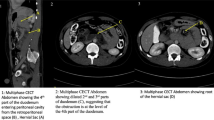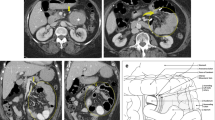Abstract
Background
Internal hernias are uncommon in children and their clinical and imaging findings have not been widely addressed.
Objective
To determine the spectrum of clinical and imaging findings of internal hernia (IH) in children and to highlight diagnostic features.
Materials and methods
Review of clinical, imaging and surgical findings in 12 children with surgically proven IH.
Results
IH found in seven girls and five boys. Five of the children were neonates and seven were between ages 8–17 years. All neonates presented acutely and had transmesenteric internal hernias (TMIH) (four congenital, one acquired). In the older children, five presented with chronic symptoms and two presented with acute symptoms; the former had paraduodenal hernias (all congenital) and the latter had a congenital pericecal and an acquired TMIH. Only 2/5 neonatal TMIH could be appreciated on GI contrast examination. All five paraduodenal hernias were easily diagnosed on UGI series. CT, in two older children, depicted a paraduodenal hernia and the acquired TMIH. In 7/10 (70%) congenital IH, there was associated malrotation (in all four right paraduodenal hernias).
Conclusion
There is a wide spectrum of clinical and imaging findings of IH in children. TMIH were difficult to appreciate on GI contrast examinations, but paraduodenal hernias were easy to appreciate. One must have a high index of suspicion for right paraduodenal hernia if UGI series shows duodenum and proximal small bowel to the right of the spine.








Similar content being viewed by others
References
Ghahremani GG (2000) Abdominal and pelvic hernias. In: Gore RM, Levine MS (eds) Textbook of gastrointestinal radiology, 2nd edn. Saunders, Philadelphia, pp 1993–2009
Meyers MA (1970) Paraduodenal hernias. Radiologic and arteriographic diagnosis. Radiology 95:29–37
Dengler WC, Reddy PP (1989) Right paraduodenal hernia in childhood: a case report. J Pediatr Surg 24:1153–1154
Donnelly LF, Rencken IO, deLorimier AA et al (1996) Left paraduodenal hernia leading to ileal obstruction. Pediatr Radiol 26:534–536
Prada-Arias M, Sanchís-Solera L, Pérez-Candela V et al (2007) Computed tomography diagnosis of symptomatic right paraduodenal hernia associated with enteric duplication cyst. J Pediatr Surg 42:1938–1941
Page MP, Ricca RL, Resnick AS et al (2008) Newborn and toddler intestinal obstruction owing to congenital mesenteric defects. J Pediatr Surg 43:755–758
Martin LC, Merkle EM, Thompson WM (2005) Review of internal hernias: radiographic and clinical findings. AJR 186:703–717
Takeyama N, Gokan T, Ohgiya Y et al (2005) CT of internal hernias. Radiographics 25:997–1015
Okino Y, Kiyosue H, Mori H et al (2001) Root of the small bowel mesentery: correlative anatomy and CT features of pathologic conditions. Radiographics 21:1475–1490
Blachar A, Federle MP, Brancatelli G et al (2001) Radiologist performance in the diagnosis of internal hernia by using specific CT findings with emphasis on transmesenteric hernia. Radiology 221:442–428
Fujita A, Takaya J, Takada K et al (2003) Transmesenteric hernia: report of two patients with diagnostic emphasis on plain abdominal X-ray findings. Eur J Pediatr 162:147–149
Black PR, Mueller D, Crow J et al (1994) Mesenteric defects as a cause of intestinal volvulus without malrotation and as the possible primary etiology of intestinal atresia. J Pediatr Surg 29:1339–1343
Merrot T, Anastasescu R, Pankevych T et al (2003) Small bowel obstruction caused by congenital mesocolic hernia: case report. J Pediatr Surg 38:E11–12
Ramachandran P, Sridharan S (2003) Strangulated left paraduodenal hernia in an infant. Pediatr Surg Int 19:120–121
Moran JM, Salas J, Sanjuán S et al (2004) Paramesocolic hernias: consequences of delayed diagnosis. Report of three new cases. J Pediatr Surg 39:112–116
Shinohara T, Okugawa K, Furuta C (2004) Volvulus of the small intestine caused by right paraduodenal hernia: a case report. J Pediatr Surg 39:e8–9
Mboyo A, Goura E, Massicot R et al (2008) An exceptional cause of intestinal obstruction in a 2-year-old boy: strangulated hernia of the ileum through Winslow’s foramen. J Pediatr Surg 43:e1–3
Fan HP, Yang AD, Chang YJ et al (2008) Clinical spectrum of internal hernia: a surgical emergency. Surg Today 38:899–904
Drewett M, Burge DM (2009) Late-onset volvulus without malrotation in preterm infants. J Pediatr Surg 44:358–361
Pershad J, Simmons GT, Chung D et al (1998) Two acute pediatric abdominal catastrophes from strangulated left paraduodenal hernias. Pediatr Emerg Care 14:347–349
Antao B, Hamill J, Samuel M et al (2005) Herniation through the foramen of Winslow presenting as obstructive jaundice. Pediatr Surg Int 21:560–562
Yagnik V, Patel P, Patel A (2009) Congenital internal hernia: a rare cause of small-bowel obstruction. Internet J Surg 20:1
Vaos G, Skondras C (2007) Treves’ field congenital hernias in children: an unsuspected rare cause of acute small bowel obstruction. Pediatr Surg Int 23:337–342
Park CY, Kim JC, Choi SJN et al (2009) A transmesenteric hernia in a child: gangrene of a long segment of small bowel through a large mesenteric defect. Korean J Gastroenterol 53:320–323
Ko SF, Tiao MM, Huang FC et al (2008) Internal hernia associated with Meckel’s diverticulum in 2 pediatric patients. Am J Emerg Med 26:86–90
Ming YC, Chao HC, Luo CC (2007) Congenital mesenteric hernia causing intestinal obstruction in children. Eur J Pediatr 166:1045–1047
Garignon C, Paparel P, Liloku R et al (2002) Mesenteric hernia: a rare cause of intestinal obstruction in children. J Pediatr Surg 37:1493–1494
Tainaka T, Ikegami R, Watanabe Y (2005) Left paraduodenal hernia leading to protein-losing enteropathy in childhood. J Pediatr Surg 40:E21–23
Jabra AA, Eng J, Zaleski CG et al (2001) CT of small bowel obstruction in children: Sensitivity and specificity. AJR 177:431–436
Blachar A, Federle MP, Dodson S (2001) Internal hernia: clinical and imaging findings in 17 patients with emphasis on CT criteria. Radiology 218:68–74
Blachar A, Federle MP (2001) Bowel obstruction following liver transplantation: clinical and CT findings in 48 cases with emphasis on internal hernia. Radiology 218:384–388
Jamieson D, Stringer DA (2000) Small bowel. In: Stringer DA, Babyn PS (eds) Pediatric gastrointestinal imaging and intervention, 2nd edn. BC Decker, Hamilton, pp 311–474
Author information
Authors and Affiliations
Corresponding author
Rights and permissions
About this article
Cite this article
Tang, V., Daneman, A., Navarro, O.M. et al. Internal hernias in children: spectrum of clinical and imaging findings. Pediatr Radiol 41, 1559–1568 (2011). https://doi.org/10.1007/s00247-011-2158-4
Received:
Revised:
Accepted:
Published:
Issue Date:
DOI: https://doi.org/10.1007/s00247-011-2158-4




